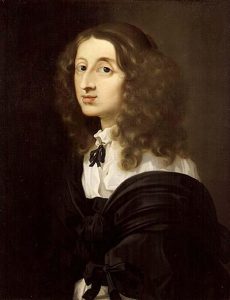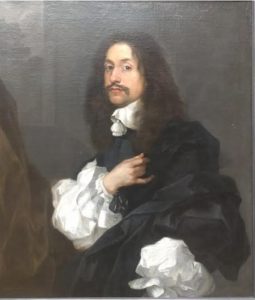Christina och att resa inkognito
Theresa Kutasz Christensen, PhD – Art Historian specializing in provenance research and the history of collecting by women

Sébastien Bourdon, olja på duk. Nationalmuseum, NM 1072.
Today, most people are familiar with “incognito mode” on their web browsers as a setting which helps cloak your identity and online activity. In the early modern period, to be incognito or “unrecognized” often included literal cloaking and was a widely utilized tool for those who, for political, personal, or social reasons, wanted to maintain a degree of anonymity while moving about in public spaces. For members of the nobility and royalty in the mid-17th century, even the simplest social engagement often came with an extensive list of protocols dictated by increasingly nuanced rules of Baroque etiquette. These social regulations along with robust channels for gossip meant that individuals often attempted to conduct their business incognito. This was the case for Christina who spent portions of her post-abdication journey from Sweden to Rome in 1654-55 traveling incognito.
The decision to be incognito could be applied in situations as simple as walking in a nearby garden with an associate or as complex as taking extended trips to other cities or countries under an assumed identity. Depending on the individual and the occasion, incognito could also mean a range of modes of disguise. To be incognito one could simply not announce themselves, dress in unadorned clothes, use an assumed name, don a cloak, or attend events without the fanfare of attendants. In many cases the goal was to avoid gossip or rules of decorum that would oblige one to engage in endless formalities and reciprocal invitations. Unlike the exaggerated disguises used as a plot device in many plays of the period, real world applications of incognito were largely of this social nature and the total disguise of a person’s appearance was not always needed. While Christina was in the Spanish Netherlands, she attended the theater to discuss political and familial matters with Elizabeth Stuart who brought along one of her daughters. All three women were noted to have attended the event incognito. It is unlikely that Christina and her companions that day significantly altered their physical appearance in order to take the meeting.
In other situations, including Christina’s, being incognito could require drastically changing a person’s appearance or the presentation of their gender so as to attempt to remain truly anonymous (or close to it). This was done with less frequency and was reserved for situations involving heated political issues, personal safety, or extreme social circumstance. Christina was noted to have donned this type of persona incognito on at least three occasions during her initial journey to Rome. When she travelled in this manner, Christina assumed the identity of a member of the Swedish nobility called the Earl or Count of Donau who was ostensibly embarking on a grand tour of Europe. She was said to have had her hair cut shorter and she wore fashionable men’s clothes. Her masculine disguise would likely look quite feminine to our modern eye and hardly like the velour pants suits of Greta Garbo’s Christina.

Sébastien Bourdon, 1657/58, oil on canvas, Art Institute of Chicago, 1975.582 (Photo: Author)
While incognito, Christina most likely would have worn a pair of stockings, shoes with a decorative buckle or flower, a pair of flowing or generously billowed knee-length pantaloons, and a masculine cut to her jerkin with black ribbons at the shoulder, a high-waist, and large skirt-like tabs around the mid-section. The ensemble would have been completed with a billowing white linen or cotton shirt with black ribbons at the collar and cuff, a style which was popular with both men and women at the time and in which she was depicted in her often-copied portraits by Sébastien Bourdon and David Beck. In the mid-17th century, women’s and men’s garments could be constructed very similarly with the primary distinction between the two often being the comportment of the wearer. This can be observed in many contemporary accounts of Christina’s appearance which talk interchangeably about her wardrobe, her decorum, and her intellect as having a masculine aspect. These observations are often repeated in more modern biographical overviews of the queen without taking into account the extent to which the latter two aspects influenced perceptions of the former and vice versa.
According to Galeazo Priorato, who chronicled Christina’s travels through 1654-55, the queen used her masculine disguise to travel from the Swedish border through Denmark. She then resumed wearing feminine clothing in Hamburg. The vast majority of her time was spent as herself; however, on at least one occasion, when passing through areas where she might be a political target, she was compelled to dress as her alter ego in order to travel safely. As the queen was known to have had a noticeable physical deformity to her shoulder, it is likely that the masculine choice of clothing for such occasions offered an additional layer of protection in concealing her identity.
Various accounts of the meetings that she took incognito in 1655 have a less ominous overtone and her assumption of the Earl’s identity was chronicled by her biographers as playful or mischievous; in some aspects mirroring the ways that characters in plays from the period used disguise. The majority of scholarship on crossdressing and dressing incognito in early modern Europe focuses on the many occurrences in theatrical productions and its use as a literary trope. In plays, the appearance of characters incognito often serves as a plot device that allows them to meet in secret, cheat, deceive, entertain, seduce, or escape. Christina was a great fan of the theater and in some instances, she took advantage of her exceptional set of circumstances for her own edification and amusement. In one such instance, Christina uses her alter ego to enter the male space of a Jesuit library. In that case her hosts almost certainly knew her true identity and the Jesuits made it a point to flatter her by obsequiously praising the intellect of the Swedish queen while in her disguised presence. After her public conversion to Catholicism at Innsbruck, Christina abandoned the use of her alter ego and there are no further accounts of her need to assume a male identity to pass incognito. The majority of scholarship on early modern travel incognito focuses on the topic in the context of theater and literature. There is a great deal more to be learned by expanding our understanding of Christina’s movements incognito and other real-world applications of this common but understudied social practice.
For Further Reading:
Primary Sources:
Burbury, John. The history of the sacred and Royal Majesty of Christina Alessandra Queen of Swedland. London: 1658.
Chevreau, Urbain. A relation of the life of Christina queen of Sweden with her resignation of the crown, her voyage to Brussels and her journey to Rome Whereunto is added, her genius. London: Printed by J.C. for Henry Fletcher, 1656.
Priorato, Galeazzo Gualdo. Historia della Sacra Real Maestà di Christina Alessandra Regina di Suetia. Rome: Nella Stamperia della Rev. Camera Apost., 1656.
Secondary Literature:
Decker, R.M. The Tradition of Female Crossdressing in Early Modern Europe. London: Palgrave Macmillan, 1989.
Lanoye, Diederik. “The Stay of Queen Christina of Sweden in the Spanish Netherlands, 1654–1655.” The Court Historian Vol. 5, no.2, 2000.
Masson, Georgina. Queen Christina. New York: Farrar, Straus & Giroux, 1969.
Strohm, Reinhard. “Le Roi Caché: Incognito in the Dramma per Musica.” Il Saggiatore Musicale 23, no. 2 (2016): 163-88.
Strömquist, Liv. Kunskapens frukt. Stockholm: Ordfront Förlag, 2014.
Woodcock, Philippa. “Early Modern Monarchy and Foreign Travel- Entourage and Anonymity,” in The Routledge History of Monarchy, Elena Woodacre et al. eds. Abingdon: Routledge, 2019, 282-299.
Images:
Drottning Kristina
Sébastien Bourdon, 1653, oil on canvas, Nationalmuseum, Stockholm, NM 1072, (Photo: Anna Danielsson / Nationalmuseum) http://collection.nationalmuseum.se/eMP/eMuseumPlus?service=ExternalInterface&module=collection&objectId=18075&viewType=detailView
Portrait of an Unkown Man,
Sébastien Bourdon, 1657/58, oil on canvas, Art Institute of Chicago, 1975.582 (Photo: Author)
Theresa Kutasz Christensen, PhD – Art Historian specializing in provenance research and the history of collecting by women TKutaszChristensen@gmail.com